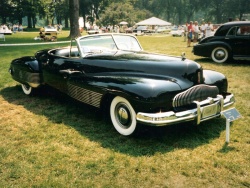 1939 Buick Y-Job. Click image to enlarge |
Article and photo by Bill Vance
The arrival of the new 1927 LaSalle from Cadillac is credited with formalizing automobile styling. General Motors’ premium Cadillac brand was celebrating its silver anniversary and introduced this lower priced “companion car” LaSalle to fill the price gap between Cadillac and Buick. Before the LaSalle, car shapes were generally dictated by the engineers to meet the mechanical needs.
GM president Alfred P. Sloan, Jr., had discussed improving the appearance of GM’s cars with his executives, and on a California trip Cadillac’s general manager Lawrence Fisher discovered a talented young man by the name of Harley Earl who was working for Cadillac distributor Don Lee creating custom-styled cars for movie stars and other wealthy patrons.
Fisher was so impressed with Earl’s creations that he was convinced GM should hire him to style the new LaSalle. It would be the first time a manufacturer had applied aesthetics to the automobile in a significant or formalized way.
Earl was hired under contract to style the LaSalle and his imaginative use of colour, lines and shape on the new model was so successful that president Sloan invited him to join the corporation full time to organize and run a new Art and Colour Section. Reporting directly to Sloan, it would serve all GM divisions and it would complement perfectly the evolving concept of the annual model change that Sloan was championing.
What had been a branch of engineering, styling was now being established in this new entity called Art and Colour. It was later renamed Styling, and became critically important to the industry.
Automobile styling flourished at GM, and soon in the rest of the industry. But Earl’s imaginative and fertile mind was casting much further into the future than next year’s models. It was this vision that resulted in the industry’s first concept car, the Buick Y-Job completed in 1939. It would be a seminal car, just as the LaSalle had been.
During this era, the teardrop form, a la the Zeppelin, was seen as the ideal aerodynamic (then called streamlining) shape. The Lincoln Zephyr and Chrysler/DeSoto Airflow were examples. Earl used this idea as his basis, but stepped boldly ahead. With the Y-Job (he borrowed the letter Y from the aircraft industry where it was used it to denote experimental airplanes). Earl in effect extended the concept of the teardrop and in so doing predicted the shape of the automobile for many years to come.








